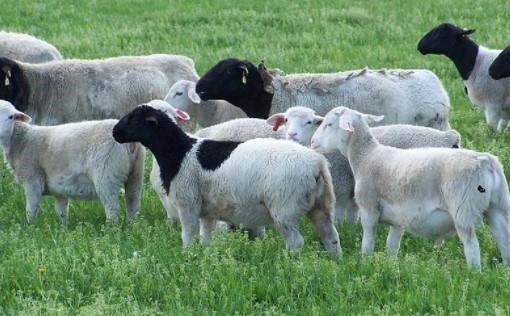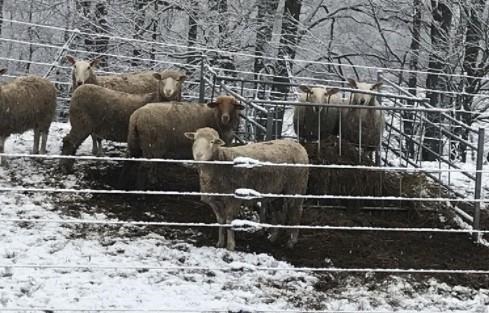By Melanie Barkley
Feeding the sheep flock is a critical aspect of sheep production and management. Good nutrition influences the overall health status of the entire flock, as well as the growth performance of lambs. This is particularly important throughout the breeding season and pregnancy. Sheep need to eat a balanced diet in order to be healthy and productive.
Diets are balanced with six classes of nutrients. These six classes of nutrients include water, carbohydrates, lipids (fats), protein, vitamins, and minerals. The proper balance of these nutrients can be achieved with a wide range of feed ingredients. A well-balanced diet will help ensure embryo survival and can also lead to healthy and vigorous lambs at birth.
Water is by far the most essential “nutrient" in a sheep's diet. Fresh, clean water should always be available. Stale or dirty water will lead to decreased water intake, which ultimately will decrease feed intake. Decreased feed intake will decrease lamb growth and could impact pregnancy status of ewes. Water tests should be conducted periodically. Water can impact the uptake of another essential class of nutrients, minerals. Water concentrations of sulfur and other potentially toxic minerals should be evaluated. Inadequate water intake can also impact an animal’s ability to excrete waste. Be sure to plan for increased water intake when the temperature is above 70 degrees F and during very cold temperatures. Sheep normally consume between one half to one and a half gallons of water per day depending on the temperature and humidity.
The other five nutrients, carbohydrates, fat, protein, minerals, and vitamins, as stated previously are met through a variety of feedstuffs. The most common feedstuffs to meet the nutrient requirements of sheep for these essential nutrients are discussed mainly as ingredients, bearing in mind that the sheep require daily only the nutrients, not necessarily every ingredient discussed.
Pasture is an excellent source of nutrients for the sheep flock and is often one of the cheapest sources of feed for most operations. When grazing sheep, there are fundamental objectives that producers should keep in mind.

Pasture should be maintained at four inches in height or taller to help prevent sheep from consuming parasite larva.
Pasture height is critical for sheep health to prevent infections with internal parasites. Most parasite larva can be found in the first two inches of forage growth. Therefore, pasture forages should be maintained at four inches or higher to prevent infection. Pastures can also be rotated every four to six days, or less, to allow grazing sheep to stay ahead of a parasite’s life cycle. For fall grazing, sheep can be rotated through crop residues or through hay fields. This will provide a “clean” pasture area with no parasite larva present while still providing adequate nutrition. For crop residue fields, be sure to subdivide the fields, using temporary fencing, so that sheep better use all of the residues without wasting them by trampling and fecal contamination.
During the fall of the year, the grazing season can also be extended with stockpiled forages. These pastures have basically been saved for fall grazing by keeping animals off these fields for several months and allowing forages to regrow. Begin stockpiling forages around the middle of August to the first of September to be grazed in November and December. This high-quality fall forage should meet the nutritional needs of sheep during early and mid-gestation.
Regardless of when and where you graze, the forage quality must meet the nutrient requirements of the sheep. Forages are better quality, contain more protein and carbohydrates to supply energy while in a growing vegetative state without any seed heads. Producers should clip seed heads to keep the forages in this vegetative state throughout the grazing season, as forage growth will slow when maturity is reached and seed heads develop.
If adequate quantity and quality of forage is not available to graze, average quality to high-quality hay should meet the nutritional needs of pregnant ewes. Thin ewes, with body condition scores of less than 3, should gain weight to maintain their pregnancy and target a body condition score of 3 to 4 by the time they lamb. This can be accomplished with high-quality forage or by supplementing their diet with concentrates (i.e. grains). More information about body condition scoring sheep can be found at the Penn State Extension fact sheet: Body Condition One More Evaluation Tool .
During early gestation, defined as the first 15 weeks of pregnancy, fetal lamb growth is minimal and a ewe’s nutritional requirements are similar to her maintenance requirements. Thus, during early gestation, ewes can consume average quality pasture or stored forages. However, nutrition does play a critical role in ensuring embryonic survival. Therefore, a ewe’s diet must at least meet requirements in order to ensure adequate nutrients to support placental development. Drawing from the previous example of body condition, a ewe in early gestation should be maintaining body condition, not losing condition. Monitor ewes every two weeks to ensure condition remains adequate.
Much of the fetal growth occurs during the last third of gestation, the four to six-week period at the end of the pregnancy. During this time, the ewe should be supplemented to meet the increased nutrition demands for the added fetal growth and to allow her to produce adequate quality and quantity of colostrum, the antibody rich milk consumed by the lamb in the first twenty-four hours after birth. Energy consumption during the last third of pregnancy will affect the size and vigor of newborn lambs as well as ewe milk production. Increasing energy consumption will also prevent pregnancy toxemia. Pregnancy toxemia is a condition that occurs when pregnant ewes are using more nutrients than they are consuming, thus they are drawing heavily on body reserves. In general, energy requirements for a ewe carrying a single lamb increase 50% over her maintenance requirements, while energy requirements for a ewe carrying twins increase 75%. Therefore, during the last four weeks of gestation, ewes should consume 59 to 65% TDN, 10.5 To 11.5% crude protein and approximately 3.5 to 4.5 lbs. dry matter.
Due to the increased nutrient requirements during the last four to six weeks of gestation, ewes may not be able to consume a large enough quantity of forage, particularly when carrying more than one lamb. Body capacity becomes an issue as the lambs increase in size and there is less room for the stomach to expand for forage consumption. Therefore, most sheep producers supplement ewes with some type of grain in the last trimester to increase energy consumption and sometimes protein concentrations in the daily ration. The rate at which producers supplement grain varies from one half to one pound per ewe each day, depending on ewe size and genetics. In colder climates and with ewes that often produce triplets, the supplemental feed should be started four to six weeks prior to parturition (birth of the lambs). Always remember that any ration changes should occur gradually over a period of several days.
During the winter months, producers should increase the amount of feed offered to sheep to compensate for the additional energy the animal needs to keep warm in cold temperatures. The lower critical temperature at which rations should be adjusted varies based on fleece length. The lower critical temperature for a freshly shorn sheep is 50 degrees F, while the lower critical temperature for a sheep with a 2 ½ inch fleece is 28 degrees F. (Source: Sheep Production Handbook). Wind chills also contribute to additional energy needs and should be accounted for when making feeding adjustments.
Fleeced animals can perform very well in cold temperatures. However, energy requirements increase greatly with cold rains (temperatures in the 30’s and 40’s) and ice. A wet fleece can drain nutrient reserves of an animal. Thus, if possible, bring animals indoors or provide additional shelter in the event of cold rain or ice storms.

A free choice source of forage is one way producers can increase nutrient supply to sheep to account for additional energy required to keep themselves warm during cold weather conditions.
Sheep are more tolerant of temperature changes than other livestock, due to the insulation value of their wool. Due to varying fleece lengths, it becomes difficult to accurately predict increased energy needs. Many producers provide forages free choice during cold winter months, which allows sheep to increase consumption as needed. Producers who hand-feed forages can adjust hay supply based on decreased temperatures and any residual left in the feed bunk between feedings. Forages are key to maintaining body temperature in winter months because fermentation in the rumen makes heat and helps keep animals warm.
While forages and concentrates supply the bulk of the sheep’s carbohydrate, protein, and fat requirements, they are often lacking or imbalanced in vitamins and minerals. Because of this, sheep producers should also provide free choice access to a trace nutrient mix formulated for sheep. These mixes often contain salt to stimulate intake and contain a combination of minerals and vitamins formulated specifically to meet the micronutrient requirements of sheep. It is important to note that cattle micronutrient supplements often contain toxic levels of the mineral copper and should not be fed to sheep. A well-balanced sheep mix should be available at all times throughout the year. Failure to supplement these micronutrients results in low fertility, weak lambs at birth, lowered milk production, impaired immunity, and can lead to numerous metabolic disorders.
Paying close attention to nutrition throughout the year can lead to not only healthier sheep, but also more productive sheep. For help with balancing rations, contact a local nutritionist or your local Penn State Extension office to locate an educator who can assist in developing a feeding program for your flock.
Source : psu.edu